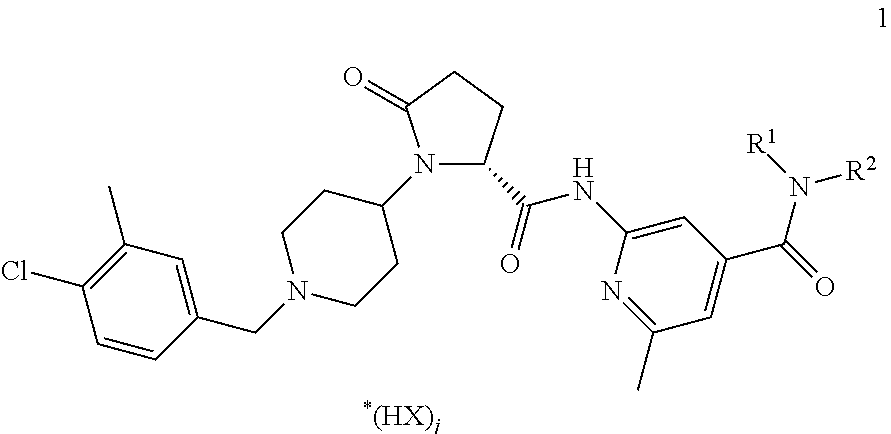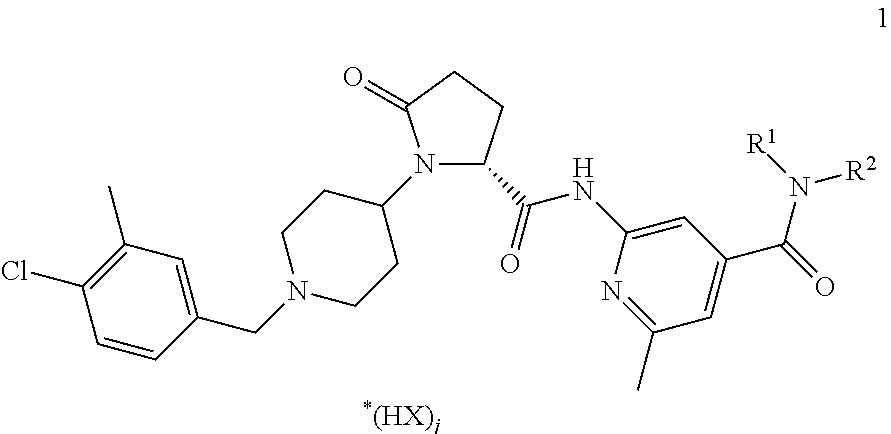Pharmaceutical formulations comprising ccr3 antagonists
a technology of ccr3 and antagonists, which is applied in the direction of drug compositions, immune disorders, extracellular fluid disorders, etc., can solve the problem that standard manufacturing processes such as direct compression or aqueous granulation cannot be applied to the compound
- Summary
- Abstract
- Description
- Claims
- Application Information
AI Technical Summary
Benefits of technology
Problems solved by technology
Method used
Image
Examples
example 1
Tablet Formulation—Wet Granulation
[0151]Copovidone is dissolved in ethanol at ambient temperature to produce a granulation liquid. An active CCR3 antagonist ingredient compound of formula 1, lactose and part of the crospovidone are blended in a suitable mixer, to produce a pre-mix. The pre-mix is moistened with the granulation liquid and subsequently granulated. The moist granulate is optionally sieved through a sieve with a mesh size of 1.6-3.0 mm. The granulate is dried at 45° C. in a suitable dryer to a residual moisture content corresponding to 1-3% loss on drying. The dried granulate is sieved through a sieve with a mesh size of 1.0 mm. The granulate is blended with part of the crospovidone and microcrystalline cellulose in a suitable mixer. Magnesium stearate is added to this blend after passing through a 1.0 mm sieve for delumping. Subsequently the final blend is produced by final blending in a suitable mixer and compressed into tablets. The following tablet composition can b...
example 2
Tablet Formulation—Melt Granulation
[0152]An active CCR3 antagonist ingredient compound of formula 1, lactose, part of the microcrystalline cellulose, polyethylene glycole, lactose and part of the crospovidone are blended in a suitable mixer, to produce a pre-mix. The pre-mix is heated in a high shear mixer and subsequently granulated. The hot granulate is cooled down to room temperature and sieved through a sieve with a mesh size of 1.0 mm. The granulate is blended with part of the crospovidone and microcrystalline cellulose in a suitable mixer. Magnesium stearate is added to this blend after passing through a 1.0 mm sieve for delumping. Subsequently the final blend is produced by final blending in a suitable mixer and compressed into tablets. The following tablet composition can be obtained:
Componentmg / tablet% / tabletActive ingredient28.50030.0Crospovidone1.5001.6Lactose11.00011.6Polyethylene glycole14.30015.1Microcrystalline cellulose5.7006.0−>Total (granulate)61.000 −>64.3Microcry...
example 3
Tablet Formulation—Hot Melt Granulation
[0153]An active CCR3 antagonist ingredient compound of formula 1, mannit, polyethylene glycole and part of the crospovidone are blended in a suitable mixer, to produce a pre-mix. The pre-mix is heated in a high shear mixer and subsequently granulated. The hot granulate is cooled down to room temperature and sieved through a sieve with a mesh size of 1.0 mm. The granulate is blended with part of the crospovidone and mannit in a suitable mixer. Magnesium stearate is added to this blend after passing through a 1.0 mm sieve for delumping. Subsequently the final blend is produced by final blending in a suitable mixer and compressed into tablets. The following tablet composition can be obtained:
Componentmg / tablet% / tabletActive ingredient28.50030.0Crospovidone1.5001.6Mannit16.70017.6Polyethylene glycole14.30015.1−>Total (granulate)61.000−>64.3Mannit31.00032.6Crospovidone2.5002.6Magnesium stearate0.5000.5Total95.000100.000
PUM
| Property | Measurement | Unit |
|---|---|---|
| Fraction | aaaaa | aaaaa |
Abstract
Description
Claims
Application Information
 Login to View More
Login to View More - R&D
- Intellectual Property
- Life Sciences
- Materials
- Tech Scout
- Unparalleled Data Quality
- Higher Quality Content
- 60% Fewer Hallucinations
Browse by: Latest US Patents, China's latest patents, Technical Efficacy Thesaurus, Application Domain, Technology Topic, Popular Technical Reports.
© 2025 PatSnap. All rights reserved.Legal|Privacy policy|Modern Slavery Act Transparency Statement|Sitemap|About US| Contact US: help@patsnap.com



